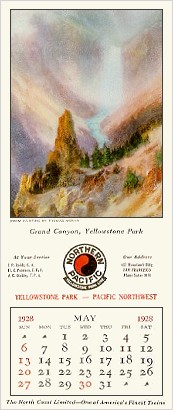Work in the west also commenced at about this same time. Although the precise location for the western terminus had yet to be named, some twenty-five miles of track were laid through the Cowlitz Valley between Kalama and Puget Sound. The final destination for the NP's western depot was not chosen until two years later, when Tacoma was designated in the fall of 1872. Once begun, track-laying for the Northern Pacific would be subject to the roller-coaster ride of the national economy until the final railheads were driven.
 In addition to marketing efforts, aimed at both potential immigrants, who might settle the land, and at the upper classes, from whom Cooke & Company sought potential investment capital, the Philadelphia bank sold bonds to finance construction. Cooke wanted to raise one hundred million dollars for his railroad. During the next three years, crews from the east laid tracks across Dakota Territory; in the west, the rail line was expanded until it reached Tacoma, Washington Territory.
In addition to marketing efforts, aimed at both potential immigrants, who might settle the land, and at the upper classes, from whom Cooke & Company sought potential investment capital, the Philadelphia bank sold bonds to finance construction. Cooke wanted to raise one hundred million dollars for his railroad. During the next three years, crews from the east laid tracks across Dakota Territory; in the west, the rail line was expanded until it reached Tacoma, Washington Territory.
The Northern Pacific's labour pool was comprised of nearly 4,000 men; more than half of them (appx 2,600) were Chinese immigrants. As the crews made their slow but inexorable progression to the east, many Chinese ventured out to the surrounding countryside to try their hand at prospecting. It was they who first discovered gold at Sauk Creek, near what is now the Blewett Pass Highway in southern Chelan County.
The Chinese were quickly displaced as word of their discovery spread, causing white prospectors to rush into the area. Farther down on the Columbia River, the Chinese again discovered gold. Another rush ensued, led by white prospectors. Though they once more forced out those who had initially discovered the minerals, these frequent sojourns into the land surrounding the railroad tracks were creating mini-boomtowns replete with saloons, restaurants, hotels, a general store or two, brothels, and livery stables. Several shacks, cabins and tents which housed the miners dotted their myriad construction sites. The Blewett Mining and Milling Company was established to exploit the myriad mineral deposits.
By early 1873, the bonds which had been touted to underwrite financing of the Northern Pacific were no longer selling well enough to sustain expenses. Cooke's bank overextended itself, and on 18 September 1873, this eastern pillar of finance closed its doors. Confidence in the American banking system, already in question due to the preceeding few years of recession, collapsed completely, giving rise to the great Panic of 1873. Work on the Northern Pacific subsequently underwent its own collapse, and it would be nearly five years before the sound of railheads being driven would be heard again in the northern wilderness.
(continue)
next page






